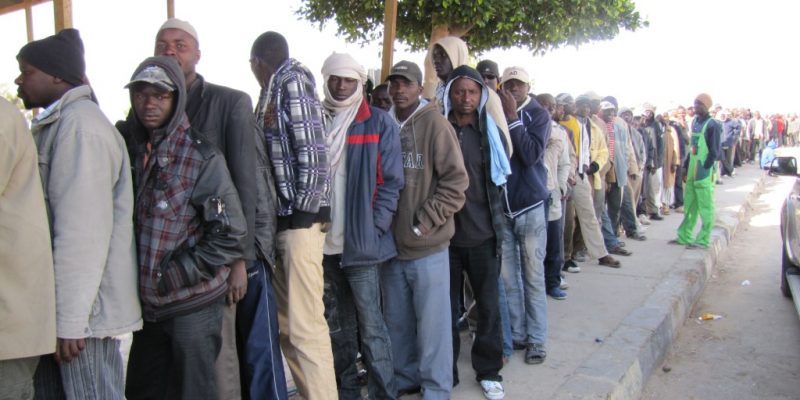1. How the Libyan Coast Guard wants to take control of the Mediterranean
The seizing of a Spanish NGO vessel by Tripoli’s Coast Guard raises several questions on the situation in the Mediterranean. Annalisa Camilli wrote in Internazionale about the Coast Guard’s threats (who have been trained by Italy) that forced the NGOs to suspend rescue operations, leaving an alarming humanitarian gap out at sea.
2. The Libyan hell and the collusions between smugglers, militias and the Coast Guard
Francesca Mannocchi’s report for L’Espresso takes us right into the Libyan hell, as told by the survivors who endured daily horrors in the starving, corrupt African country and who denounced the collusions between smugglers (who have turned human trafficking into a business), militias and the Coast Guard. A must read.
3. Mediterranean: what happened at the Libyan border
Between the code of conduct, the attacks and the campaign against humanitarian NGOs, Ottavia Spaggiari writes in Vita about the final weeks of the Seefuchs, the Sea-Eye vessel that was forced to retreat to Malta, following a series of threats by the Libyan Coast Guard.
4. Flow of migrants to Italy slows, but nobody really knows why
The last two months have seen a dip in the number of migrant arrivals on Italian shores. The government claims that the code of conduct and the deal with Libya are working, but others say that the real causes are more complex and uncertain. Read Patrick Kingsley’s in-depth article in the New York Times and the article in Il Post.
5. The link between Giulio Regeni and the migrants
“There is a not so invisible thread connecting the decision to send the Italian ambassador back to Cairo and Italy’s policy on migration from Libya. It’s the thread that tied our hands when we decided that the only thing we can do with migrants is to send them back to Libya; and in order to talk to certain parts of Libya, we need to talk with Egypt”, wrote Mattia Toaldo in L’Espresso (print edition) – perfectly summing up Minniti’s strategy to stop the flow of migrants, a plan that includes the Tebu clan as well as Al Sisi.
6. What’s behind the code of conduct for NGOs?
It has been eloquently dubbed “the code of mass distraction” because it’s supposed to act as a diversion from the real issues (the deal with Libya, the growing power of its dangerous Coast Guard and the pushbacks to the living hell that is the country). What’s behind the code of conduct for NGOs and how should the humanitarian organisations respond? Refugees Deeply asked a selection of expert, including our own senior editor Marina Petrillo.
7. The consequences of migrant detention in Italy
A few months ago, Italy’s ombudsman for the rights of persons detained had already expressed his concerns over migrant detention. Two incidents have now brought the issue back into the headlines: the Association for Juridical Studies on Immigration (ASGI) has filed a complaint to the ECHR over the case of fourteen unaccompanied foreign minors, who were illegally detained at the hotspot of Taranto in June. Meanwhile, a decision by the first civil chamber of the Bari Court sentenced the Presidency of the Council of Ministers and the Minister of the Interior to pay the City of Bari 30,000 euros because the presence of the CIE (Identification and Expulsion Centre) has damaged the image of the municipality (“think of what happened to the communities in Auschwitz and Guantánamo”, the judge wrote). Read the in-depth analysis by Gaetano De Monte in Osservatorio Diritti and the story in Repubblica.
8. Rome, the eternal city without a plan for asylum seekers
On a hot August morning, at 7am, law enforcement officers evacuated a building in Rome, on via Curtatone, while all the occupants were still asleep. 800 people were forced out on the streets, most of them Eritreans or Ethiopians, asylum seekers, recipients of international protection or long-term residents, many of them with children. No notice and no alternative. Eleonora Camilli has been following the developments (which have raised concerns in the UNHCR) and writing about it in Redattore Sociale. Also read our in-depth story on the lack of a plan for migrants and refugees in Rome, the only European capital where volunteers are doing all the work.
9. A group of Syrian refugees fights for justice
A group of Syrian torture victims, now refugees in Germany and supported by the European Centre for Constitutional and Human Rights, have taken a key step on the long road towards justice under the principle of pure universal jurisdiction, submitting a criminal complaint for torture they suffered in Assad’s prisons. Read Stephanie Ott’s article in Al Jazeera.
10. What the fake, racist meme about Samuel L. Jackson and Magic Johnson has taught us
“Migrants camping out on benches using our money”, “Tell me if these are people fleeing war”, people commented on the Internet. But the two “migrants” in the viral picture were actor Samuel L. Jackson and former NBA star Earvin “Magic” Johnson, sitting on a bench while on holiday in Forte dei Marmi, near Lucca. The meme was created, along with a caption that was meant to be ironic, by comic actor Luca Bottura, as a “social experiment”. It proved once again how posts on social networks serve to confirm prejudice in users, regardless of what the truth is. Read the articles in Repubblica and IB Times.
Translation by Francesco Graziosi.
Header photo: migrants at the Egyptian-Libyan border – via European Commission DG Echo.









